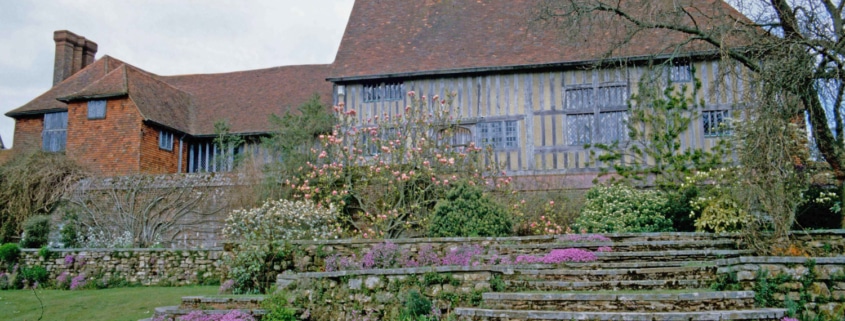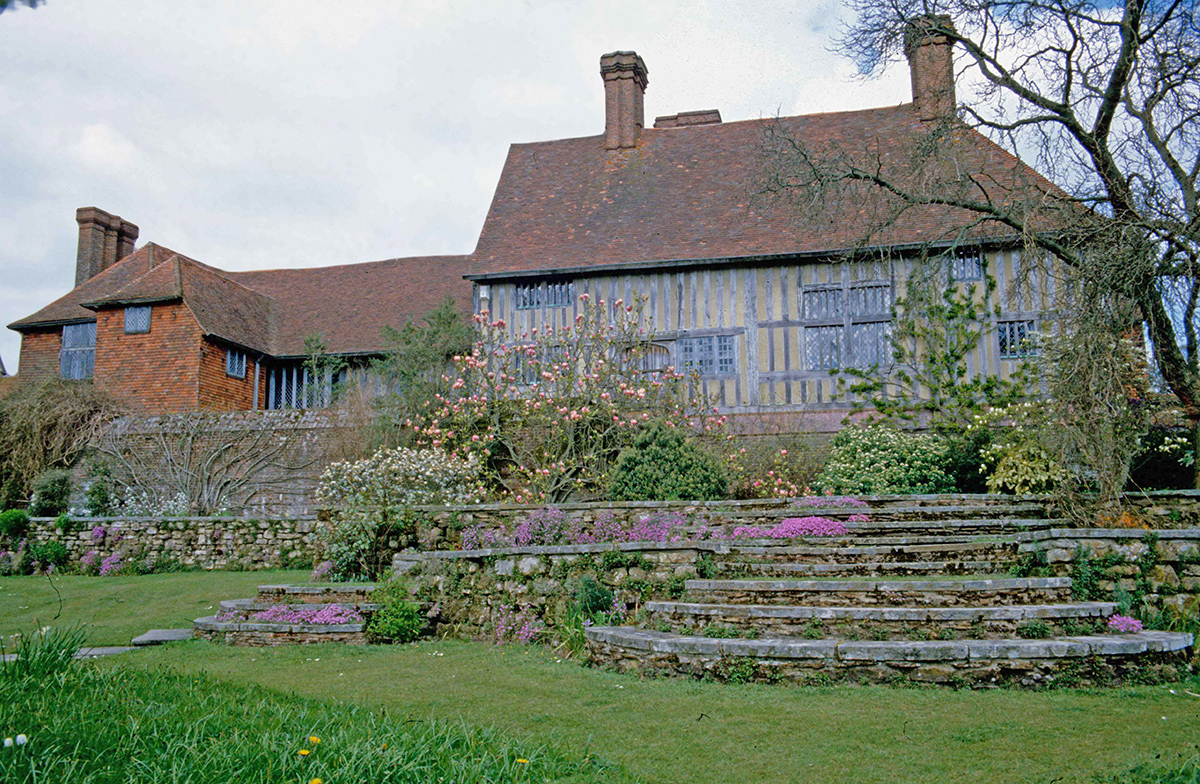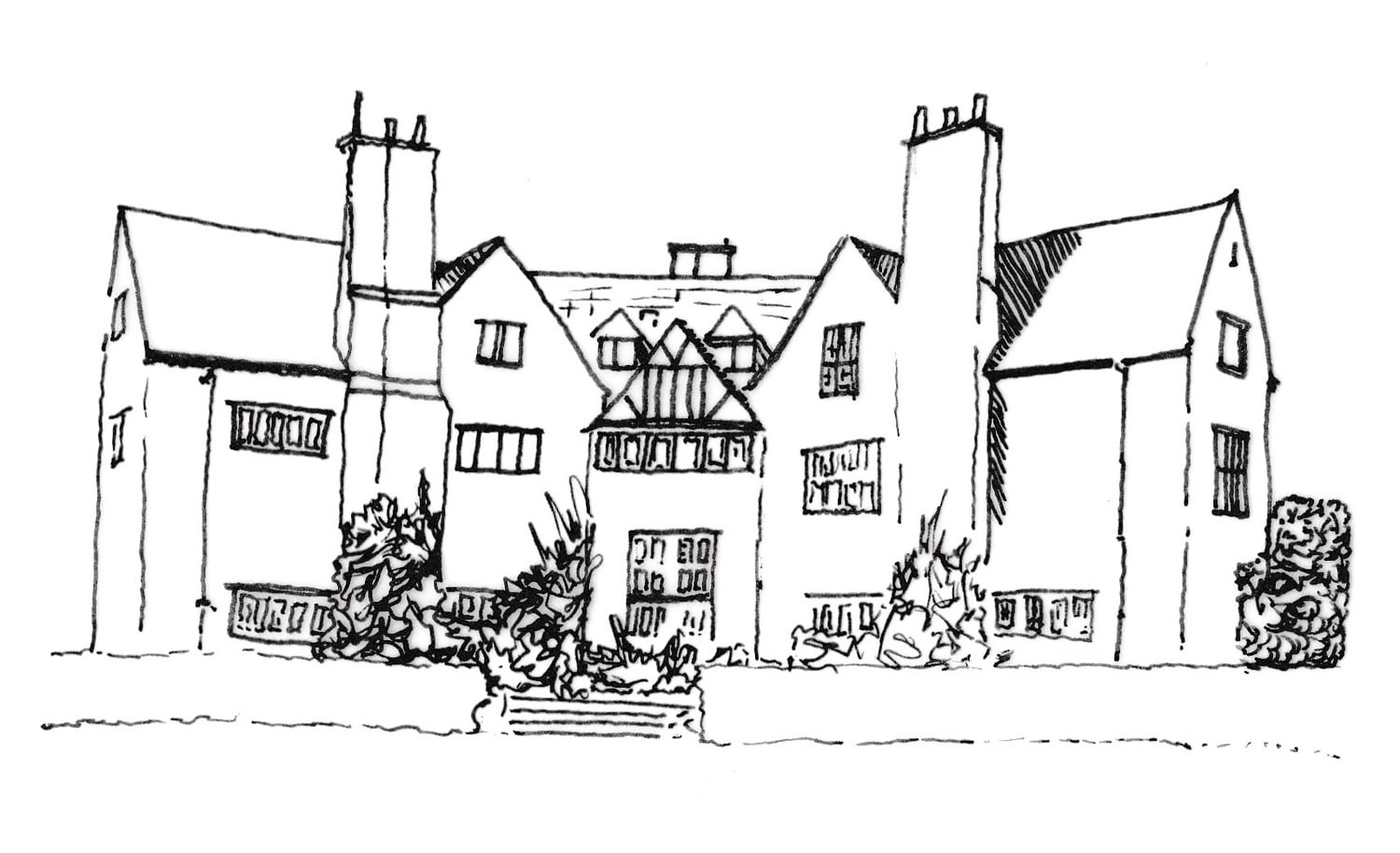
Description
This was a very intricate restoration work. Nathaniel Lloyd asked Lutyens to renovate a 15th-century timber-framed house, and at the same time attach to it another smaller timber-framed house which he had rescue and transported from Benenden in Kent. Lutyens joined the two together by setting the Benenden house on a plinth, with a series of steps leading down to the garden in a concave convex progression. New additions, behind the Benenden house, form a lovely oak-lined Arts and Crafts interior. The staircase has open lattice sides and delightful newels. There is a crawling window in the nursery, which is L-shaped. (Lutyens used to say that all nurseries should be this shape so that a child could hide from his nanny.) The three parts are unified by tile-hanging on the new additions and an enveloping tiled roof. (Amery et al., 1981, cat no.142)Great Dixter, 1 m. nw. As one approaches Great Dixter, one is faced by a fabulous piece of half-timbering on the r., all narrowly set uprights, and a restrained tile-hung piece on the l. That on the r., including the two-storey porch represents the hall and cross-wing of the house probably built by Sir Thomas Etchingham soon after 1464. It was purchased by Nathaniel Lloyd in 1910. He invited Ernest George and Lutyens to prepare sketches for restoring and enlarging it, choosing Lutyens, who built what we see to the l. of the porch (on the site of the long-demolished service end of the medieval house), one of his most successful domestic jobs, combining sensitivity to the old with quite some daring, discreetly concealed. Brick below, tile-hung above, all under sweeping tiled roofs and with the usual prominent chimneystacks. The geometrical build-up of roofs, dormers and chimneys is particularly appealing from the ne. Behind this range, i.e. se, the view of the house is a surprise; for here, equally well integrated, Lloyd and Lutyens re-erected a c15 timber-framed hall house from nearby Benenden, across the Kent border. Close studded, with a jetty to the e and raised over a high brick basement. The mullioned hall window in two tiers. The four-centred arched e doorway is original. By Lutyens the big roof. The s stair-turret projecting from the angle of the hall and cross-wing is Lutyens also, on the site of a smaller original that gave access to the upper floor in the cross-wing. At the s end of the latter, on the ground floor, an eight-light window was discovered and restored. The lights are all arched. Against the w wall a stone chimneystack, rebuilt where there was probably one in the c15. Returning to the n front, which preserves the Wealden arrangement of recessed centre, the gable on the r. represents the parlour with solar over. Trefoil-cusped bargeboards to the gable.
One enters by the substantial porch, two bays deep and jettied on three sides, with rows of open arched lights on the ground floor. The porch leads, via a lobby, to the hall, its inserted floor removed by Lutyens. The screen to the lobby is by Lloyd (copied from one he had seen at Strawberry Hole, Northiam). After a career in business, Lloyd trained as an architect (elected a fellow of RIBA in 1931, aged sixty-four) and developed a small local practice. Many of the details in the house, doors, ironmongery etc., were copied from local details sketched or photographed by him. The hall has a bay window to the front and one to the back. They are Lutyens’s, but the canted posts at their start were the evidence of their existence, though it is likely that the rear window was not canted. Evidence for arched lights to the windows came from the chamber window, the porch and elsewhere. The hall has a roof in which hammerbeams alternate with tie-beams. The hammers support curved braces rather than hammer posts. They bear shields, the two to the n with the arms of the Etchingham family, one to the s with the arms of the Dalyngrigge family. In the solar a c16 chimneypiece with dainty carving and a crown-post truss.
The restored original house provided the Lloyds with just three rooms. Lutyens’s nw wing housed the services and further bedrooms and bathrooms – with plenty of enjoyable Lutyens joinery detail, especially the secondary staircase (modelled on one at Hushheath Manor, Staplehurst, Kent) enclosed by simple wooden trellis – and the hall from Benenden was used as a double-height bedroom, partitioned at each end of the ground floor to form a bathroom and dressing room. The Benenden hall, as elsewhere, has a crown-post truss. Against the end wall a crenellated bressumer, which oddly returns and juts into the room, forming a kind of lobby. Lutyens’s own work, to say it again, is very retiring.
By Lutyens of course the layout of the fanciful garden, encircling the house, with its unmistakable motifs, incorporating several unassuming existing agricultural buildings to good effect. On sloping ground from ne to sw Lutyens set out a series of garden rooms, contemporary with those at Hidcote, Gloucs., and well before those at Sissinghurst, Kent, divided by walls or hedges, disguising changes of level with curved steps and an archway to the Sunk Garden incorporating decorative use of tiles. sw of the house a loggia, its piers constructed of tiles laid flat. Whilst the gardens remain essentially as planned, they were altered by Nathaniel and Daisy Lloyd (e.g. the Sunk Garden in 1923) and by their son Christopher Lloyd. nw of the house, prominently sited on the approach to indicate the wealth of its owner, a contemporary barn, seven bays long, large for the High Weald. (Antram, 2013, pp.566-7)
Bibliography
Amery, C., Richardson, M. and Stamp, G. (1981) Lutyens, the Work of the English Architect Sir Edwin Lutyens (1869-1944): Hayward Gallery London, 18 November 1981-31 January 1982. London: Arts Council of Great Britain.Antram, N. (2013) Sussex: East with Brighton and Hove. The Buildings of England. New Haven: Yale University Press.
Also Cited In
Weaver, L. (1913) Houses and Gardens by E L Lutyens. London: Country Life.Aslet, C. (1982) The Last Country Houses. New Haven: Yale University Press.
Butler, A., 1950. The architecture of Sir Edwin Lutyens: the Lutyens memorial series. Vol 1: Country Houses, Country Life: London and Scibners: New York.
WEAVER, L., 1913. COUNTRY HOMES GARDENS OLD & NEW: GREAT DIXTER, SUSSEX, THE. RESIDENCE OF MR. NATHANIEL LLOYD. Country Life (Archive : 1901 – 2005), 33(835), pp. 18-26.
Listing Grade
I, IListing Reference
1216957 100736Client
Nathaniel Lloyd

